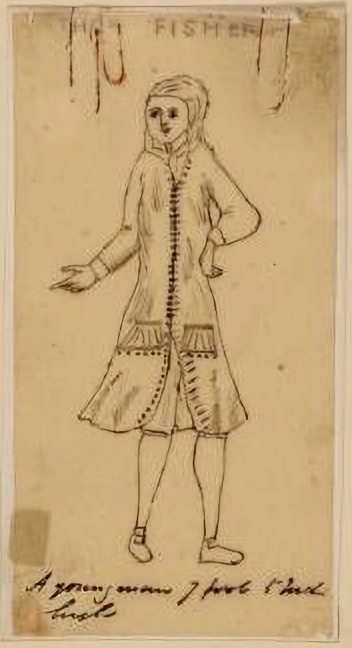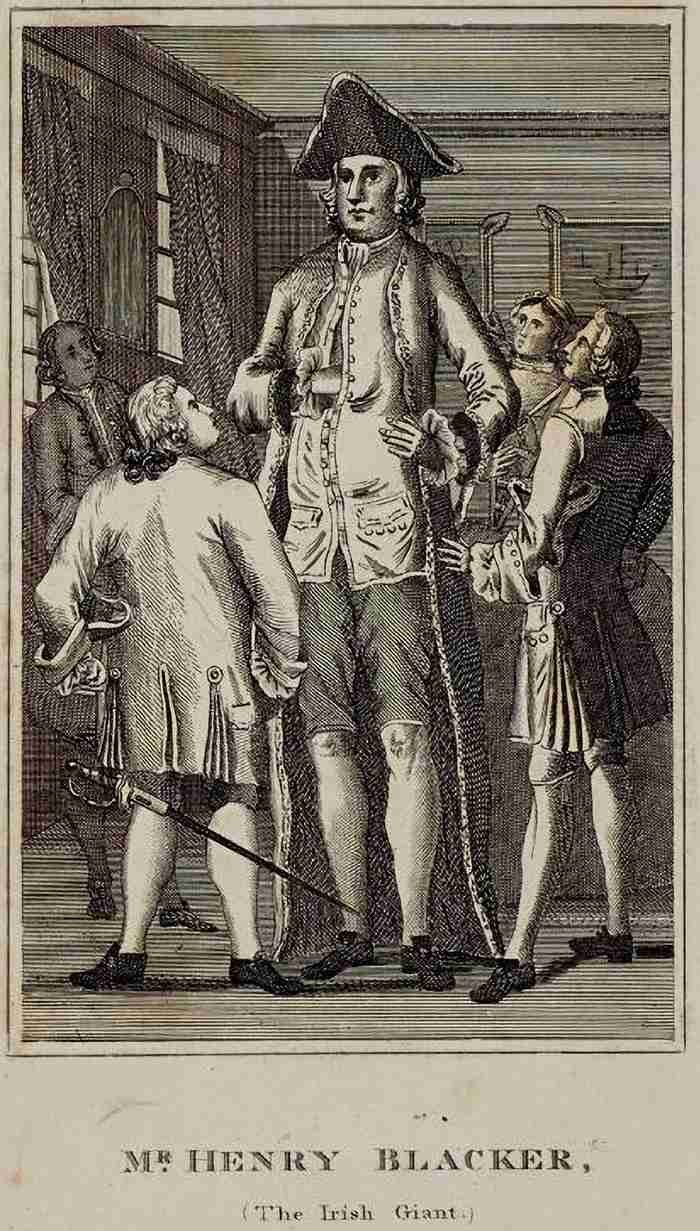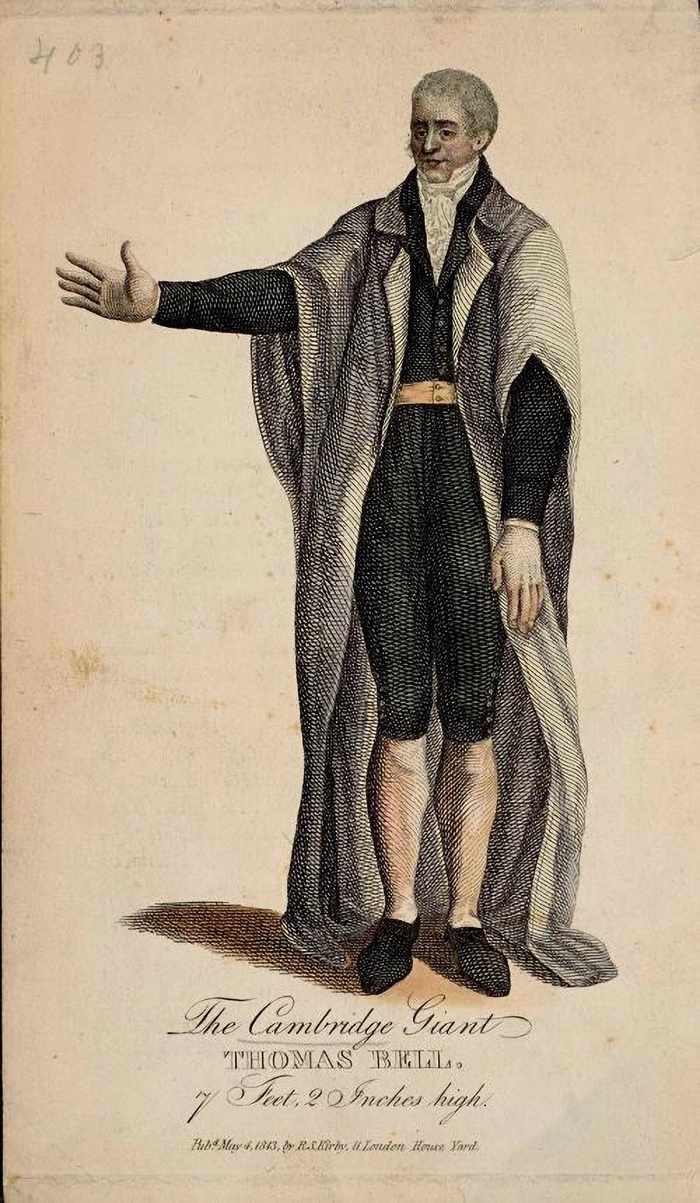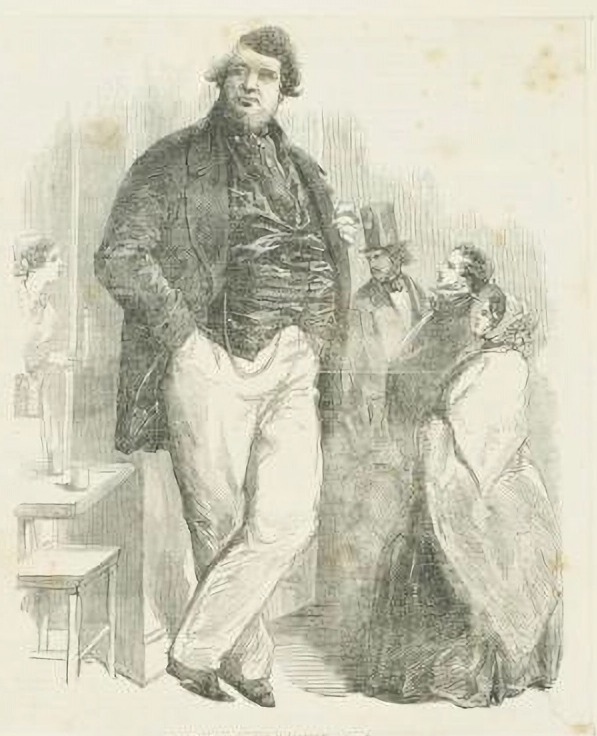Who ate jail-bait? Sat 29 May 2021
Daniel Lambert's smalls were big. Source: Daniel Lambert: The heaviest man of the 18th century
You're supposed to believe that the man for whom these breeches were made was about the same height as the men seen holding them.
Perhaps he was. But descriptions of Lambert's athleticism suggest he was taller.
Daniel Lambert
Daniel Lambert: a prototype Santa Claus. Source
From Highways and Byways in Lincolnshire, Rawnsley and Farguharson, 1915, p16:
But undoubtedly Stamford's greatest man in one sense was Daniel Lambert, whose monument, in St. Martin's churchyard, date 1809, speaks of his "personal greatness" and tells us that he weighed 52 stone, II lbs., adding "N.B. the stone of 141b." The writer once, when a schoolboy, went with another to see his clothes, which were shown at the Daniel Lambert Inn ; and, when the two stood back to back, the armhole of his spacious waistcoat was slipped over their heads and fell loosely round them to the ground
Despite being obese and - allegedly - a mere 5 feet 11 inches tall, Lambert was famous for his high kick.
From Daniel Lambert: England’s Most Famous Fat Man:
In spite of his large girth, Lambert was... able to stand on one leg and kick the other to a height of 7 feet.
The Rockettes are famous for their eye-height kicks. The tallest dancer in The Rockettes is 5 feet, 10.5 inches tall:
Even easier if you're fat. Source: Rockettes' Dance Moves
A lean, professional ballet dancer can perform grand battement kicks beyond eye-height:
Try it yourself: the grand battement. Source: How to Do a Grand Battement
Daniel Lambert's career history and weight gain are clue-worthy:
| Year | Event |
|---|---|
| 1770 | Born in Leicester to son of Leicester's jailkeeper. |
| 1778 | A keen swimmer by age eight. Rev George Oliver notes that Fen dwellers were equally at home in water. |
| 1784 | Moves to Birmingham metal button and buckle engraving factory. |
| 1788 or 1791 | Returns to Leicester as assistant jailkeeper. Starts to gain weight. |
| 1791 or 1794 | Now weighs 200Kg. |
| 1801 | Weighs 250Kg. Horse can't carry him. Gives up hunting. |
| 1805 | Leicester jail closes. [Weighs 320Kg](https://en.wikipedia.org/wiki/Daniel_Lambert). Becomes a recluse. |
| April 1806 | Moves to Piccadilly to display himself at home (for one shilling per viewer). |
| September 1806 | Begins to travel around the country displaying himself. |
| June 1809 | Dies in Stamford, aged 39, [weighing 335 Kg](https://en.wikipedia.org/wiki/Daniel_Lambert). Coffin allegedly 6 feet, 4 in long. |
Key events from Daniel Lambert's life.
Lambert was also jailer at Stamford jail. His Stamford jail dates are unknown but apparently he held both Leicester and Stamford posts at the same time.
Lambert's extraordinary weight gain after becoming a jailer suggests he developed a side-line in a popular product of the time:
17th/18th century jars labelled 'Human Fat'. Source: Human Fat
Keywords: fat, jail gaol, gel... 1
"We became their favourite meal." Source: Bullets of Justice, 2019
Other curiousities of Daniel Lambert's life:
- By his late teens, Lambert was a keen hunter, fisherman and swimmer.
- He bred hunting dogs. He was consulted for his expertise on their breeding. Writers like John Byng often write of how they used to enjoy hunting with dogs and how modern hunting dogs are much smaller and less ferocious than in the past.
- Lambert taught children to swim most of his life. This claim feels like a euphemism.
- Lambert shares with St Petersburg a tall hero who allegedly fought a bear barehanded. From Peter the Great - Wikipedia:
Peter grew to be extremely tall, especially for the time period, reportedly standing 6 ft 8 in (2.03 m). He was seen as a "second Goliath" or Samson.
- The closure of jails in which Lambert worked is at odds with the urbanisation and problems of English cities in the Industrial Revolution. Possibly they were jails for prisoners of war, such as Norman Cross, south of Stamford.
- Curiously, the area between Norman Cross and Stamford has folklore of big hunters with big dogs.
Henry De Foe Baker
Three-metre long grave, St Michael and All Saints church, Uffington, Lincolnshire.
The striped measuring pole is 2m long.
Henry de Foe Baker's grave is in Uffington churchyard, Stamford, Lincolnshire. Baker's headstone and footstone are three metres (9ft 9 in) apart. The distance between headstone and footstone indicate the coffin was 3m long (9ft). At the time of the photograph, the headstone was unreadable, but 2022's dry summer reduced the lichen, etc. It reads:
The corpse of Henry De Foe Baker XXIII years vicar of Greetham in the county of Rutland and nearly one year warden of Browne's Hospital in Stamford Here awaits in humble [indecipherable] the resurrection of the body to the life everlasting through the boundless mercy of Jesus Christ
Harriet Baker born MDCCXCVIII died MDCCCLX[indecipherable]
The footstone reads:
HDFB Born 18 October 1788 Died 3 July 1845
De Baker's footstone follows footstone protocol: initials and dates only.
'Vicar' means 'estate manager; or 'stock manager'. A manager for an absent landowner or stock owner. But it also means so much more. See Ice Age Sites of Britain's Serpents - Part Four.
De Baker was also a warden of Browne's Hospital. Which wasn't a hospital. In summary, we have an apparent giant who was warden of a 'hospital', which really seems to mean: 'inn'. He is buried in Uffington church graveyard - a graveyard just outside Burghley House.
Anne Hardy
From Highways and Byways in Lincolnshire, Rawnsley and Farguharson, 1915, p34:
The register records the death in July, 1815, of " the Lincolnshire Giantess " Anne Hardy, aged 16, height 7 ft. 2 in.
That's 215cm.
From Lincolnshire Notes & Queries, p72:
The following notice is inserted in the obituary column of the Stamford Mercury, July 21, 1815 :—
"Death of the Lincolnshire Giantess. On Monday se'n night died at Rippingale, aged 16, Anne Hardy, daughter of Thos. and Sarah Hardy of that place. This young woman had attained the extraordinary height of seven feet two inches, and had attracted much attention in this part of the country, having for a considerable time past been publicly exhibited at fairs, &c., as a phenomenon. Her father is a man not more that five feet six inches in height, and her mother only of middling stature. The coffin measured seven feet and a half in length, and two feet seven inches across the shoulders."
It was claimed for her that she was the tallest Lincolnshire woman that ever lived.
Primrose had a head for heights. Source: The Nevers
In The Nevers, the woman who introduces the two girls is Penance Adair, played by Ann Skelly.
From Ann Skelly's Height - CelebHeights:
On her spotlight page she was listed as "Height: 5'4" (162cm)
Assuming she wore Victorian boots in the clip, with 2.5cm (1 inch) heels, Ann Skelly stands 5'5" (164.5cm) tall here. At 7 feet, 2 inches, Anne Hardy would have been 50.5cm taller than Ann Skelly. 16 year old Ann Hardy would have reached just above the puff of giantess Primrose Chattoway's (Anna Devlin) right sleeve.
Incidentally, later in that episode of The Nevers, the authorities are criticised for their fascination with Primrose's underwear. An interest also seen in the photograph that heads up this article.
It's a smalls world.
More on Anne Hardy at:
- https://rvwarchive.warman.org.uk/RippingaleRecentHistory.htm which also has Rippingale butter market
- https://www.falakros.net/bourne/portrait/rippingale2.htm
Giants' Skeletons in Britain
From Archaeologia, or, Miscellaneous tracts relating to antiquity, Vol 17, p 332, at Aulcester, Warwick:
an account of the discovery of two Urns, in a piece of ground called Black Lands, situated near that town. At a little distance from the smaller urn was discovered the skeleton of a man, which measured, as it lay on the earth, nearly seven feet in length.
From Archaeologia, or, Miscellaneous tracts relating to antiquity, Vol 34, p 78, at Fairford, Gloucestershire:
The skeleton measured full six feet, but, as the head was depressed and the legs bent, I calculated that the height, in life, must have been six feet six inches. The bones were remarkably large,
I have since seen other skeletons exhumed on the same ground. The most remarkable measures seven feet. It was quite perfect, and is now in the possession of Mr. Cornwall, of Fairford.
another, perhaps the most interesting yet found. It measured six feet six
From The diary of Abraham De la Pryme, the Yorkshire antiquary, at Castor, Lincolnshire 1696-07-19, p62:
about six years ago, there was digged up several huge men bones, a jaw bone of which, a very fat man, that was standing by, easily slipt upon his own jaw.
Three Irish Giants
Three Irish giants. Source A series of original portraits and caricature etchings, Vol I, John Kay, p10
From A series of original portraits and caricature etchings, Vol I, John Kay, p10:
This Print exhibits Charles Byrne, the Irish giant, also Irishmen, who, although not in Edinburgh at the same time, have been placed by the artist in one group.
The spectators are: — Lord Monboddo, whose head appears in the background; William Richardson, solicitor-at-law, on the left behind; and Mr. Bell, engraver, in front; on the right, Bailie Kyd, a lady, and a dwarf.
Byrne, the central of the three principal figures, was eight feet two inches in height, and proportionably [sic] thick. He was born in Ireland, of which country his father was a native, but his mother was a Scotswoman. He travelled the country for the purpose of exhibiting his huge person. When in Edinburgh, he is said to have had great difficulty in getting up and down the narrow stairs of the Old Town, being obliged to crawl on all-fours.
It is also related of him that he dreadfully alarmed the watchmen on the North Bridge, early one winter's morning, by lighting his pipe at one of the lamps ; which he did with the greatest ease, without standing even on tiptoe.
He died 1st June 1783, in Cockspur Street, Charing Cross, London, aged only twenty-two. His death was occasioned by excessive drinking, to which he was always addicted, but more particularly after a loss he had sustained of almost all his savings, amounting to upwards of £700. 2 In his last moments he requested that his ponderous remains might be thrown into the sea, in order that his bones might be placed far out of the reach of the chirurgical fraternity ; and it was reported that his body was shipped on board a vessel, to be conveyed to the Downs to be sunk in twenty fathoms of water.
In the Edinburgh Evening Courant, June 9 and 10, 1783, the following notices, relative to the disposal of his body, are to be found: —
"The coffin of Mr. Charles Byrne, the Irish giant, aged twenty-three years, measures eight feet five inches within side, and the outside case nine feet four inches, and the circumference of his shoulders measures three feet four inches."
"Yesterday morning, June 6, the body of Byrne, the famous Irish giant (who died a few days ago), was carried to Margate, in order to be thrown into the sea, agreeable to his own request, he having been apprehensive that the surgeons would anatomize him."
It is to be presumed that this fancy as to the disposal of his body was in some way obviated, as his skeleton is said to be now in the Hunterian Museum, Royal College of Surgeons, London. A correspondent of the Gentleman's Magazine, Vol. XXXIII., p. 541, observes, "That Mr. Byrne, in August 1780, measured exactly eight feet; that in 1782, he had gained two inches; and that, after he was dead, he measured eight feet four inches. Neither his father, mother, brother, nor any other person of the family, was of an extraordinary size."
The two Irish giants, who are placed on each side of Byrne, visited Edinburgh in July 1784. Their presence in the northern capital was announced by various advertisements, of which we subjoin the following as a specimen : —
"IRISH GIANTS."
"The most surprising Gigantic Twin Brothers are just arrived in Edinburgh, and to be seen in an elegant apartment at Mr. Robertson's, Ladies' Hair-dresser, No. 2, opposite to the Register Office, Prince's Street.
The other two giants pictured are probably Patrick Cotter and the Living Colossus - Mr Henry Blacker. Although sometimes exhibited as an Irish Giant, Blacker was born in Cuckfield, Sussex (in 1724):
The Irish, er, English Giant. Source: Mr. Henry Blacker, The Irish Giant
At 2.3m (7ft 4 inches) high, Blacker was, however, 5cm (2 in) shorter than The Herefordshire Colossus - Edward Longmore.
Blacker was 10cm (4 in) shorter than The Yorkshire Giant - W Bradley but the same height as The Wonderful French Giant (real name unknown) and 5cm taller than Cambridge giant Thomas Bell:
Thomas Bell, 1813. Source: The Cambridge Giant
Two more giants from England were Thomas Fisher:

Thomas Fisher, the Berkshire Giant
and 2.4m (7ft, 8 in) tall Robert Hales:
Robert Hales, 1851. Source: Illustrated Newspaper clipping about The Norfolk Giant
Ringling's collections of newspaper clippings and posters about 18th/19th century giants - and dwarves - suggest hominid genetics once provided spectacular entertainment.
Remains of giants at Castor, Lincolnshire
From Diary of Abraham de la Pryme, 1695-07-19 at Castor, Lincolnshire, p62:
Mr, Baxter, minister of that place, let me see about half a score old coins that had been digg'd up about that town, some of which were Roman and others Saxon coins, and he told us, in the pinfold hard by the church (which was in the limits of the old castle) that, about six years ago, there was digged up several huge men bones, a jaw bone of which, a very fat man, that was standing by, easily slipt upon his own jaw
Remains of a giant at Chesterfield, Derbyshire
From Diary of Abraham de la Pryme, 1695? p141:
He says that about twenty years ago (c. 1674), as his father was digging very deep in Staley parish, near Chesterfield, in the said county, that they found the perfect skeliton of a man of a monstrous bigness ; the head was able to hold two pecks of corn, and this gentleman says that he has by him now one of the teeth that was then taken out of the skull, which weighs four pound nine ounces, and that which is most strange is that this skelliton was in an erect or standing posture.
De la Pryme's 1870 editor comments in the footnote:
These are the figures stated in the diary, hut it is difficult to imagine the writer gravely giving credit to the statement. If the story be not a joke, it is probable that they were the remains of an elephant. The bones of that animal have frequently been mistaken for human relics.

"...that animal have frequently been mistaken for human relics" Source
From ‘Giant’ 300,000-year-old handaxes unearthed in Kent:
These handaxes are so big it’s difficult to imagine how they could have been easily held and used.

"...that animal have frequently been mistaken for human relics" Source
From ‘Giant’ 300,000-year-old handaxes unearthed in Kent:
The two largest handaxes found at the site have a distinctive shape with a long, finely worked, pointed tip and a much thicker base.
pottery and animal bones found nearby are likely to be linked to feasting rituals at the time of burial.
Brain matter is nutritious. See Experiments with Human Consciousness.
As for the dating:
From ‘Giant’ 300,000-year-old handaxes unearthed in Kent:
The team made a second significant find at the site – a Roman cemetery, dating to at least a quarter of a million years later than the ice age activity.
How might primitive, supposedly 'prehistoric' remains appear near civilised, 'Roman' remains?
The usual way:
Worker shanties (barrios) outside Hong Kong.
© All rights reserved. The original author retains ownership and rights.
-
English pronunciation of 'gaol' is "very anomalous pronunciation of g soft before other vowels". As noted in Mark of the Flesh Market, this unusual pronunciation may link the word 'gaol' to 'gel' or 'jelly'. Ie emulsified fat products. Fat blended with water. ↩
-
Quoting the original footnote: After the death of Byrne, the note for £700 was traced to a Mr. Atkinson, who insisted that he had given value for it ; but the Giant's executor having proved that notice had been given of the theft previous to the exchange of the note, an action at law for the amount was compromised by a payment of £500. ↩
More of this investigation:
Evidence of Giants
More by tag:
#giants, #human fat, #Manimal Farm









